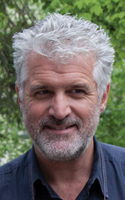
A soldier in Arkan’s Tigers, a Serbian paramilitary squad responsible for killing thousands, kicks a Bosnian Muslim civilian in Bijeljina, Bosnia in March 1992. Photo by Ron Haviv/VII
In September 2011, a group of photographers and writers who had covered the war in Bosnia met for lunch at a photo festival in the south of France. By the time coffee arrived, we had decided to make a book to commemorate the 20th anniversary of the outbreak of war. We had the support of a cast of hundreds but no money. We all agreed we wanted to make the book ourselves, design it and edit it without a publisher. We didn’t want anyone who wasn’t there to tell us how to do it, which is consistent with the way the photographers covered the war—and live their lives, for that matter.
More than 50 photographers and writers from all over the world submitted their work, which was published in “Bosnia: 1992-1995,” a book that was translated into English and Bosnian and printed in Bosnia. The book was funded by selling excerpted rights in advance of publication and through a Kickstarter campaign that took only three days. The success of the campaign was probably due to the very tight social group that was born from the war that includes journalists, aid workers, U.N. peacekeepers, and hundreds of Bosnians who became close friends—and in some cases, husbands and wives—to the foreigners who lived in Bosnia during the war. The book is much richer for that initiative.
We printed 1,500 copies of the book and gave 250 to the library system of Bosnia and to local civil society organizations. It’s a nonprofit exercise and we priced the book low so it could be sold in Bosnia, where it became a number one bestseller. The contributors include, among many others, Gilles Peress, Ron Haviv, Christopher Morris, James Nachtwey, and Janine Di Giovanni as well as Anja Niedringhaus, NF ’07, and Santiago Lyon, NF ’04. From the book came a reunion in Bosnia in 2012, which saw hundreds of journalists fly into Sarajevo from as far as New Zealand and South Africa to meet local and overseas colleagues. It was a very emotional meeting that resulted in many of us re-engaging with the country and determined to do more there.



